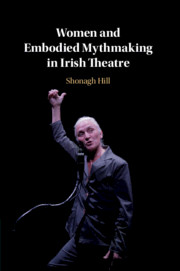Book contents
- Women and Embodied Mythmaking in Irish Theatre
- Women and Embodied Mythmaking in Irish Theatre
- Copyright page
- Dedication
- Contents
- Acknowledgements
- Introduction: A Creative Female Corporeality
- Chapter 1 Revolutionary Bodies: Mythmaking and Irish Feminisms
- Chapter 2 Unhomely Bodies: Transforming Space
- Chapter 3 Metamorphic ‘Bodies That Matter’: Process and Resistance
- Chapter 4 Staging Female Death: Sacrificial and Dying Bodies
- Chapter 5 Haunted Bodies and Violent Pasts
- Chapter 6 Olwen Fouéré’s Corpus: The Performer’s Body and Her Body of Work
- Bibliography
- Index
Introduction: A Creative Female Corporeality
Published online by Cambridge University Press: 29 August 2019
- Women and Embodied Mythmaking in Irish Theatre
- Women and Embodied Mythmaking in Irish Theatre
- Copyright page
- Dedication
- Contents
- Acknowledgements
- Introduction: A Creative Female Corporeality
- Chapter 1 Revolutionary Bodies: Mythmaking and Irish Feminisms
- Chapter 2 Unhomely Bodies: Transforming Space
- Chapter 3 Metamorphic ‘Bodies That Matter’: Process and Resistance
- Chapter 4 Staging Female Death: Sacrificial and Dying Bodies
- Chapter 5 Haunted Bodies and Violent Pasts
- Chapter 6 Olwen Fouéré’s Corpus: The Performer’s Body and Her Body of Work
- Bibliography
- Index
Summary
The impact of idealized myths of femininity, including the trope of woman-as-nation, is addressed through embodied mythmaking as a consideration of the reiteration, reperformance and reinscription of myths on and through the body. Stasis and containment define violent mythmaking, yet the chapter also looks to the possibility of myth’s liberating and utopian function. Counter to the unhomely experience which marks woman’s displacement outside of culture, the introduction proposes the potential for women’s mythmaking to reconceive spaces, myths, and theatrical forms which accommodate female expression. The assertion of a creative female corporeality redresses scholarly neglect of female bodies; both their creativity and their histories. The introduction addresses the overarching question of this book, namely how to ‘house’ the body of women’s work in Irish theatre, and proposes a new paradigm, the genealogy, as a means of remodelling our understanding of the development of Irish theatre. Deploying a feminist genealogy enables the assertion of a coalition of women in Irish theatre united by their unhomely experience and mobilized through the collective action of embodied mythmaking.
- Type
- Chapter
- Information
- Women and Embodied Mythmaking in Irish Theatre , pp. 1 - 25Publisher: Cambridge University PressPrint publication year: 2019

